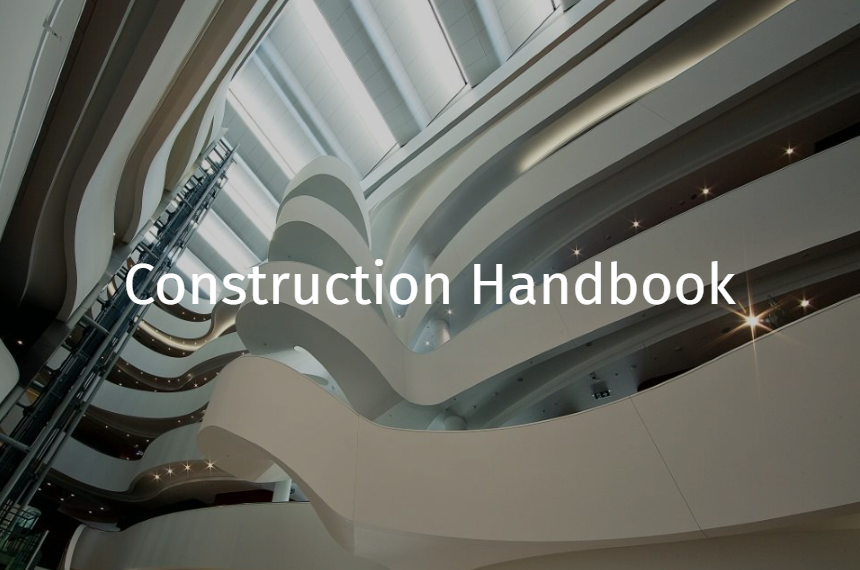Risk Management
Multiplex’s approach to HSE risk management is based on:
- Identification of hazards
- Risk assessment / evaluation
- Risk control / treatment
- Review of control measures.
Consultation with the workforce is essential in all aspects of HSE risk management.
Identification of Hazards
Hazards can be identified in a variety of ways including:
- Risk workshops
- Design review
- Hazard reports
- Observation
- Incident investigation reports
- Review of industry alerts / information
- Safe Work Methodology / Task review / assessment
- Workplace / plant inspections
- Workplace audits

Risk Assessment / Evaluation
Assessment of risk is based on evaluation of potential consequences and likelihood of an event occurring.
It is essential that risks are assessed and evaluated by competent people (i.e. those with the relevant knowledge, skill and experience).
Risk assessments must consider existing controls (verification required).
The tables outlined in the Operational Procedure - Risk and Opportunity Management - AUS IMS P 020 and included below must be used when determining the potential consequence and likelihood.
RISK ASSESSMENT EVALUATION TABLES – NSW, QLD, WA
Table 1: Likelihood Descriptions – NSW, QLD, WA
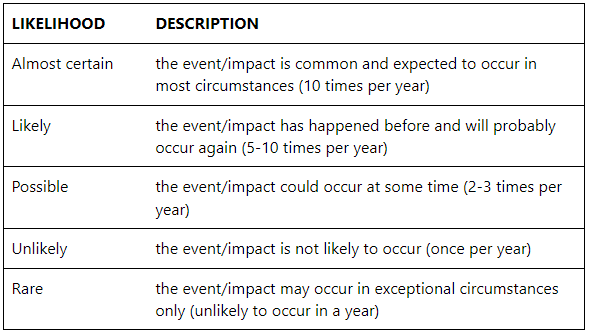
Table 3: Qualitative Risk Matrix – NSW, QLD, WA
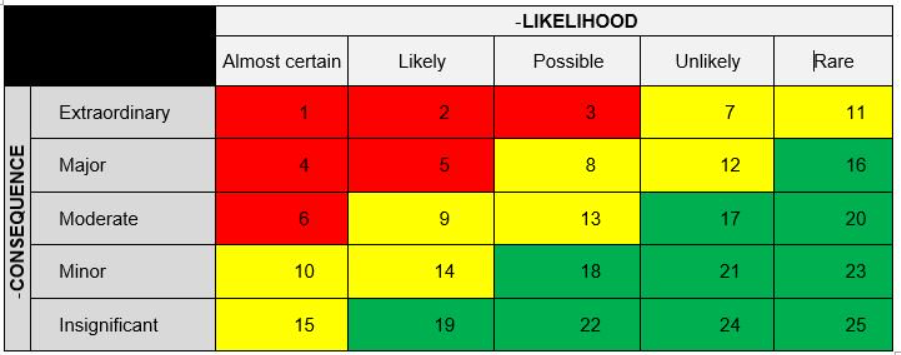
RISK ASSESSMENT EVALUATION TABLES - VIC
Table 5: Likelihood Descriptions - VIC
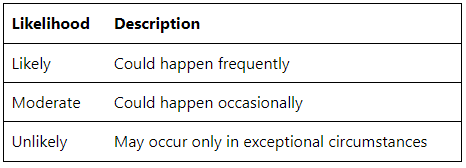
Table 7: Qualitative Risk Matrix - VIC
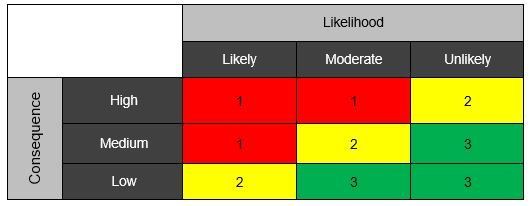
Table 2: Consequence Descriptions – NSW, QLD, WA

Table 4: Risk Rating – NSW, QLD, WA
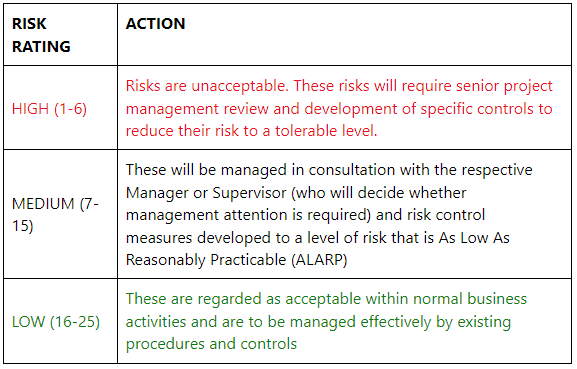
Table 6: Consequence Descriptions - VIC

Table 8: Risk Rating - VIC
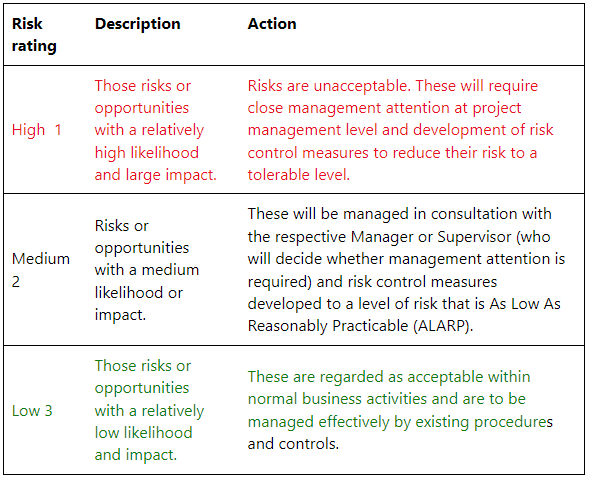
Risk Treatment / Control
The hierarchy of control (HOC) is utilised to address identified hazards and risk.
The hierarchy describes the level of control in terms of effectiveness and reliability.
Elimination is considered to be the most effective, reliable and robust control, and personal protective equipment the least effective.

Reasonably Practicable
When evaluating the type and level of control, the following is required to be considered:
- Degree of harm that may result from exposure to the hazard or risk
- Likelihood of the hazard or risk occurring
- Knowledge about the hazard or risk
- Ways of eliminating or minimising the risk
- Availability and suitability of controls that may eliminate or minimise the risk
NOTE: The cost of a control should only be considered when grossly disproportionate to the risk, i.e. the level of risk is considered low and the cost to control is comparatively high.
Safety in Design
Safety in design aims to eliminate or mitigate health and safety risks during project design stages.
Assessment of health and safety risks is undertaken at key design stages for all works. These assessments consider the implications of health and safety risks throughout a building’s lifecycle, including during construction or demolition, for the end user / occupier, for maintenance personnel and for any future refurbishment / demolition.
Peer Reviews
R Project peer reviews are conducted at various stages/activities of the project to identify all significant risks or opportunities and to develop control strategies relating to risk on the project.
Project Risk Workshops
R Project risk workshops are conducted to identify all significant risks or opportunities and to develop control strategies relating to risk on the project.
Safety in Design Risk Workshops
R Safety in Design risk workshops are conducted to identify and consider potential risks throughout the various design stages and endeavour to design out / mitigate risks applicable to the whole building lifecycle (i.e. during construction or demolition through to operational phases).
Workshops for complex structures and / or elements should consider:
- The construction phase analysis i.e., checking/verifying that the temporary and permanent state is not adversely impacted by the proposed/planned construction methodology and any incremental loading.
Note: Complex structures and elements include (but are not limited to): - raking columns
- V columns,
- cantilevered elements that exceed 5m or hanging structures,
- mega-load transfers,
- spanning walls and trusses, and
- a-typical load path structures (ie. structural systems or elements that deviate from typical or standard load-bearing configurations)
- Control measures in which the design can be modified to eliminate or minimise the health and safety risks so as is reasonably practicable.
- Responsibilities for managing identified SiD risks and implementing controls
For additional requirements, refer to Procedure AUS DMS P 060 Design Review, Verification and Validation
Risk Workshops
R Risk workshops are conducted to identify key risks and develop control strategies relating to high risk trades and construction processes with input from subcontractors and where required, other stakeholders. Risk workshops must be documented.
Risk workshops should be conducted for the following high risk activities:
- Asbestos removal
- Working in confined spaces
- Demolition
- Electrical
- Excavation and trenching
- Explosives/Blasting
- Structure (incl. perimeter screens and formwork and falsework)
- Jumpforms
- Removal of lead paint
- Piling / anchors – ground improvement
- Precast concrete
- Roofing
- Structural steel erection
- Tower cranes (erecting, dismantling, climbing and dual lifts)
- Façade
- Hoist (erection and dismantling)
- Plantrooms (NSW)
- Risers (NSW)
Safe Work Method Statements (SWMS)
S SWMS must be developed and implemented for high risk work performed on Multiplex projects.
SWMS must be developed in consultation with personnel who perform the task.
SWMS must be project / task-specific.
SWMS’s are required for high risk work activities including but not limited to activities / tasks listed below:
- Concrete cutting and coring work
- Construction, climbing and dismantling of jump or slip form
- Demolition work
- Dogging or rigging or scaffolding work
- Installation, use and removal of cantilevered decks
- Erecting or dismantling formwork
- Erecting or dismantling hoardings
- Erecting, maintaining, climbing or dismantling tower cranes
- Erection, climbing, dismantling of formwork screens
- Façade installation, removal or maintenance
- Hot works, including welding, oxy cutting and use of angle grinders
- Installation, use and removal of cantilevered decks
- Mobile crane set–up and use
- Operation of mobile plant, cranes, hoists or, concrete pumps
- Piling work
- Post-tensioning of concrete (stressing)
- Precast concrete construction work
- Suspended scaffold work (swinging stages)
- Tunnel construction
- Underground services
- Work adjacent to water or other liquids where there is a risk of drowning
- Work at height >2 m
- Work in an area where there are artificial extremes of temperature
- Work in or adjacent to special environments, prisons, hospitals, schools etc.
- Work in or around a rail reserve Erection, climbing, dismantling of formwork screens
- Work involving a confined space
- Work involving contaminated soils
- Work involving excavation to a depth greater than 1.5 metres
- Work involving structural alterations requiring temporary support to prevent collapse
- Work involving the disturbance or removal of ACM
- Work involving the use of personal fall restraint equipment
- Work on or adjacent to roadways or railways used by road or rail traffic
- Work on or near chemical, fuel or refrigerant lines
- Work on or near energised electrical installations and services
- Work on or near pressurised gas distribution mains and consumer piping
Safe Work Method Statement Review
Prior to the commencement of any high risk work activity subcontractors must submit SWMS to MPX for review. The review must be documented on the MPX SWMS Review Checklist.
MPX Site Managers / Supervisors are responsible for the review of SWMS for high risk work activities in their area of responsibility, prior to the commencement of the activity and for monitoring compliance during the activity.
R MPX and Subcontractors are responsible for confirming that:
- Their workers have been consulted during the development of SWMS
- Their workers are inducted into the SWMS by their supervisor
- Their workers sign the SWMS to confirm they understand and will comply with SWMS requirements
- Their workers and supervisors are competent to complete the work as documented in the SWMS and
- SWMS are maintained to effectively manage and address risks associated with the work.
Document Control
Version 1 August 2019 – New Procedure
Version 2 - September 2021 - Additional risk workshops add for NSW (Risers and Plantrooms)
Version 3 – January 2024 – Incorporation of additional requirements relating to Safety in Design and Complex structures and / or elements






